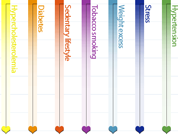The heart is a muscle that pumps oxygenated blood to our organs, which is vital. It beats an average of 60 to 80 times a minute, during which time it propels 5 to 6 litres of blood into circulation.
The heart needs to be provided with energy continuously because, as opposed to other muscles, it never stops contracting. The supply of oxygen, therefore, has to be constant regardless of the situation. When making an effort or expressing a strong emotion, it will beat faster in order to supply increased quantities of oxygen to your body. However, under these conditions, the heart will have an increased need for oxygen as well. The harder and faster your heart beats, the more oxygen it requires.
This oxygen supply is provided by a network of blood vessels which form a crown around the heart, hence their name: the coronary arteries. There are 2 main ones, namely left and right. Just like branches of a tree, they are larger at their origin and end with small ramifications. When the heart pumps oxygenated blood to the body, a small proportion is sent uniquely to itself so that it can benefit from the indispensable oxygen.
The coronary arteries
The left coronary artery divided into two large branches called the left anterior descending artery and the circumflex artery.
